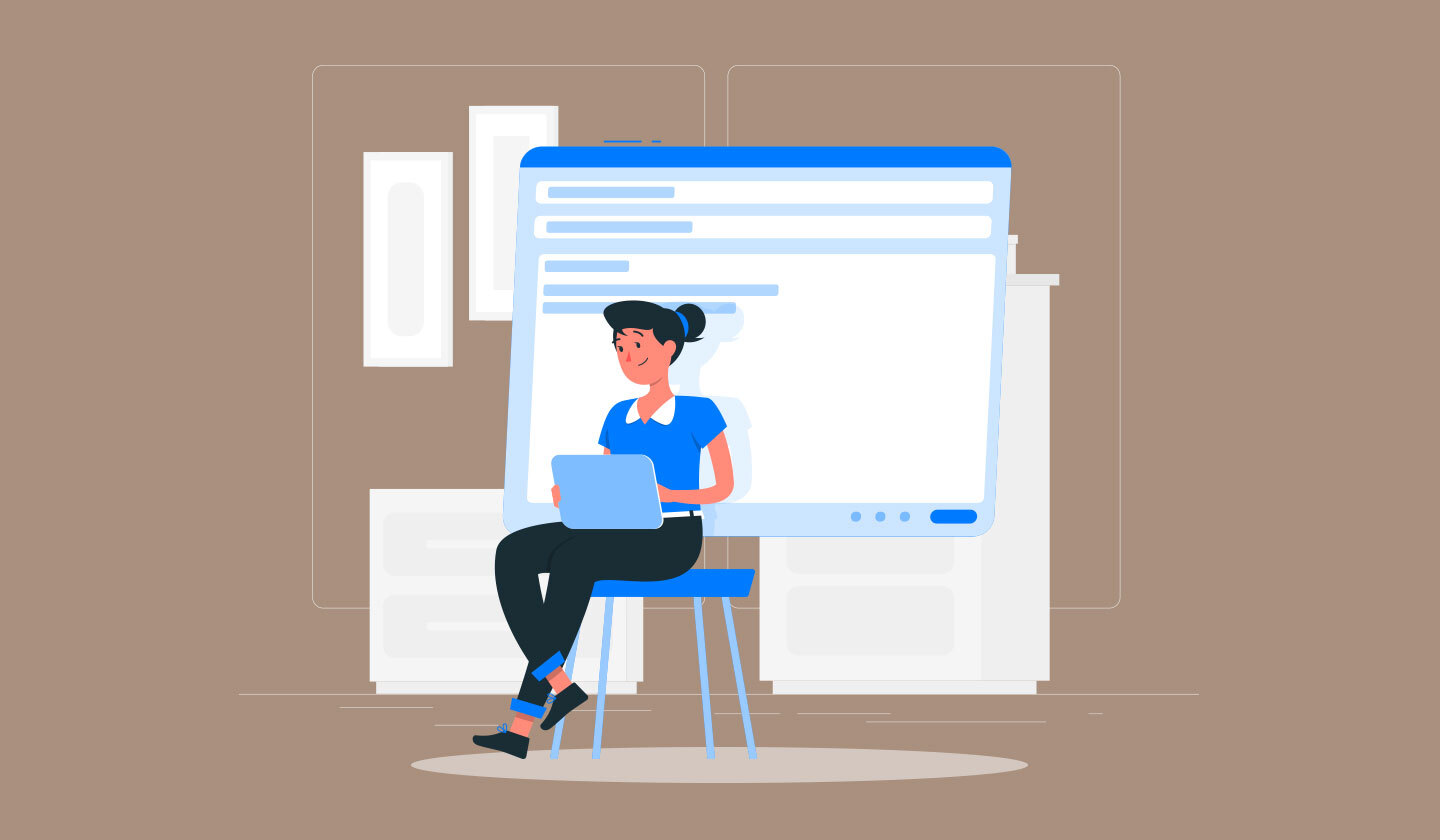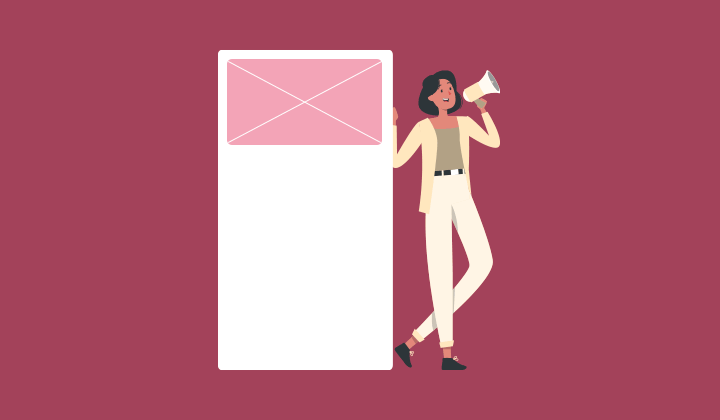When you launch a new product line, how do you announce it?
Through TV commercials? But that’s really expensive and reaches all sorts of people. Through social media campaigns? But algorithms consistently change, and posts are not always shown to your followers.
What’s the best way, you ask? Email newsletters.
40% of marketers consider newsletters the most critical element in their content marketing success. Newsletters are a great tool for nurturing leads and converting them.
Don’t know where to start? This article is your trusted guide on how to create a newsletter. Let’s begin.
What is a Newsletter?

To understand what a newsletter is, let’s break the word down into two.
What do you get?
News + Letter = Newsletter
With that equation, a letter that describes news is a newsletter. Let’s look at this in more detail; an e-newsletter is an email that introduces new product features/collections, announces changes in terms, discloses important announcements, and provides yearly roundups.
In short, a newsletter is sent to keep your subscribers updated with everything happening in your company.
What is the Purpose of a Newsletter?
Welcome emails, thank you emails, and now newsletters?
Are they really needed?
Well, 81% of B2B marketers use newsletters the most in comparison to other content types. If they’re giving newsletters such preferential treatment, it must be because of some valid reason.
Newsletters are an irreplaceable part of any company’s content strategy. The benefits they bring to the overall success are unmatchable.

The main purposes of newsletters are;
1. To strengthen customer relationships
Expecting customers to buy from you after a single promotional email is naive. Customer relationships, like plants, need to be nurtured over time. After consistently fostering them, they bloom in full force. As per a study, 31% of marketers believe that newsletters are the best content strategy for nurturing leads.
They keep your audience updated with new features, communicate testimonials of happy customers, and show the milestones you’re achieving as time passes. Little by little, your subscribers become confident with the email newsletters they read. And before you know it, they’ve rewarded your effort with their time and money.
2. To stay relevant
You’re not the only brand competing for your audience’s attention. Your competitors are doing the best they can to keep all eyes on them. How do you stay relevant and remembered? By telling them what’s new through newsletters.
Made ground-breaking sales? Tell your audience. Adptoped an environment-friendly production strategy? Tell your audience. Launching an exciting product? You guessed it - tell your audience.
This repeated influx of information increases brand recall, reduces churn, and boosts conversions - you never know when your audience is in the mindset to purchase.
3. To increase conversions
Who said newsletters couldn’t be promotional?
Yes, the focus is on providing valuable information, but you can use this opportunity to bag some sales as well. By adding relevant and enticing call to action buttons, you can successfully redirect your audience to the desired landing pages.
Once on the website, they are only a few steps away from making purchases.
How to Create a Newsletter in 5 Easy Steps?
Creating newsletters is no rocket science. Just follow the below steps to start designing newsletters that attract, add value, and convert your audience.

1. Define newsletter strategy and set frequency
Without a proper strategy in place, your newsletter will be just another email for your subscribers. To determine your plan of action, ask yourself the following questions?
What are my goals for sending newsletters? (Boost sales, strengthen customer relationships, or gain competitive edge).
Who will I send newsletters to? (Your target audience).
How frequently will I send newsletters? (Weekly/monthly/quarterly).
What will I include in the newsletter? (Product features, blog roundup, or customer reviews).
How will I measure the success of my newsletters? (Performance metrics).
Once you answer these questions, you will be better positioned to define your strategy that will streamline all future newsletters.
Setting the email newsletter frequency.
One important element of this strategy is setting the frequency right. Your newsletters might be the most valuable out there, but they will fail to impress if you bombard your subscribers with them.
You don’t want to send them so often that your audience gets annoyed and unsubscribes to them. Similarly, you shouldn’t send them so scarcely that your subscribers forget about your brand altogether. You need to find a healthy mix between both these scenarios.

We recommend sending newsletters once a month. According to multiple studies, the best days to send them are Tuesday, Wednesday, and Thursday, and the best time to send them is at 10 in the morning.
2. Gather your target audience and segment it
When developing the strategy, you determined the target audience to send newsletters to. That was the easy part. The tough job is to make your target audience subscribe to your newsletter.
If you should learn one thing from this guide, let it be this; never buy (or rent) email lists. It might seem like the easier (read: lazier) option, but the consequences are grave. You’re at risk of being fined by the Federal Trade Commission (FTC) and getting your IP blacklisted. You wouldn’t want that, now would you?
“But how do I make people subscribe to my newsletter?”
Easy, just highlight what’s in it for them. Don’t be foolish to assume people will subscribe to your newsletter out of goodwill - if it’s not valuable for them, they’ll give it a strong pass. On an optin form, mention the benefits to be realized when they subscribe.
Additionally, remember the following points:
Always communicate how often you would be sending the newsletters.
Don’t ask for too much information; name and email address would do.
Place your optin form on the website at a position where’s it hard to miss.
Offer a freebie (discount code, sample product, free consultation) in exchange for the email IDs.
Segmenting your target audience
Should you be sending the same newsletter to your entire mailing list? The answer is a big no.
The truth is people don’t reward companies who do not offer personalized experiences. The first step of email personalization is segmenting your audience. The latter simply means to divide your mailing list into groups of people with similar characteristics.

Does segmentation really work? As per one research, segmented campaigns witnessed 100.95% more clicks than non-segmented ones.
Once you have your segments ready, you can then identify how to target them through different newsletters. For instance, gender-specific newsletters can be sent to show information/pictures relevant to the gender in question.
3. Design your newsletter
Your newsletters will fail to impress if the design and content are not up to the mark. They’ll also get lost in your audience’s deep inbox clutter, which will allow your competitors to steal them away for good.
Let’s look at the email newsletter design and copy in detail.
Email newsletter design
Hiring a designer that spends days creating a newsletter was the old and inefficient way of doing things. Successful companies today benefit from readymade HTML email newsletter templates. The latter are customizable designs that can be altered as per your requirements and likings.
The newsletter templates we have at Unlayer are mobile-responsive and have been tested with Email On Acid, so they display as intended. Images, videos, social media links, and call to action buttons can be added with the userfriendly drag and drop editor.
At Unlayer, we’ve seen thousands of newsletters being designed. Here are some design best practices to level up your email newsletters:
Don’t be afraid to play with color but ensure to incorporate your brand color palette to keep the identity consistent.
Use high-quality rich multimedia, like videos, GIFs, and interactive elements, to capture your audience’s attention.
Add alternate text for all visual elements for subscribers who have turned their images off.
Incorporate dynamic content blocks to offer personalized experiences to your audience.
Stack up Call To Action (CTA) buttons instead of using just one - leave no opportunity to convert. Add one primary CTA, which should be followed by secondary ones.
Email newsletter copy
Nothing can ever replace the importance of a great newsletter copy. While a well-designed newsletter grabs attention, it is the newsletter’s content that maintains it.

How do I create high-converting newsletter content? Just follow the below tips:
Follow the inverted pyramid method
The attention span of an average human is only 8 seconds. This means you have only 8 seconds to wow your subscribers and convince them to stay. The latter is made possible through the inverted pyramid method.
As per this writing style, you mention the most important and valuable information at the top of the email. This is then followed by content that is relatively lesser important and, after that, the least important information.
When you write in such a way, your readers get hooked and are more likely to read the entire email.
Value over everything
Newsletters are primarily valuable in nature. Hence, the content you write should also be value-centric - no salesly language over here.
Talk less about yourself and more about your subscribers - their likes and dislikes, problems and solutions, and whatnot. When written in this way, your offering doesn’t seem forced or intimidating at all. Thus, increasing the possibility of your readers enjoying the newsletters and anticipating for them in the future.
Make the tone conversational
Remember, a good email should always sound like a conversation and never like a sales pitch. Your subscribers should feel as though you’re directly talking to them.
How do I make the content conversational, you ask? Refer to the following points:
Write in the second-person viewpoint (you/your).
Use easy-to-understand language and avoid jargon.
Keep your sentences short.
Include slang words only if your audience can understand them.
Keep it concise
Unlike other emails, newsletters are on the longer side. But that doesn’t mean you write a neverending newsletter. If the content is too long, your audience will simply get bored. Adversely, your subscribers’ email clients might not support the email if the content is too long as more words add to the size.
Just remember to keep the word count up to 300 words, and you’re good to go.
4. Send it to your audience.
When the newsletter design and content are ready, you can now send the email. Wait, just one more step. Before you press the send button, you need to test how the newsletter will appear on your subscribers’ email providers.

Email clients, like Gmail, Yahoo Mail, and Outlook, all load emails differently. You want your emails to look good across all the different platforms. If you’re using an email marketing software, then you can check the emails with the inbuilt testing feature. If not, just use a bunch of different email IDs and test manually.
You’re now ready to send the newsletter. We highly recommend benefitting from such softwares as they make sending a piece of cake by scheduling emails and reducing the likelihood of newsletters getting sent in the spam folder.
5. Measure newsletter performance
This step might seem unnecessary but hear us out, tracking performance, and then tweaking the design makes all the difference. You can apply all the tricks in the world, and that still doesn’t guarantee your readers will love your newsletters. Constantly monitoring and updating ensures you’re on the right track.
Here’s how you can measure your newsletter’s performance:
a. Measure against the major goal defined in step 1. If your goal was to increase sales, how successful were you in doing that?
b. Ask your subscribers what they think about the newsletters. Get on a one-on-one call or send them a survey email to know how valuable your newsletters have been.
c. Track against performance metrics. Some of the common ones are;
Open rate: The percentage of newsletters opened against the total number delivered.
Click-through rate: The rate at which the CTA buttons were clicked against the total emails delivered.
Conversion rates: The number of sales realized in comparison to the newsletters delivered.
Unsubscribe rate: The percentage of people unsubscribing from receiving your newsletters.
What to Include in a Newsletter? Ideas to Inspire You.
You know now how to design newsletters perfectly - give yourself a tap on the back. But what do you include in a newsletter? There are multiple things that you can do, but don’t get overwhelmed. The following 5 ideas provide a great starting point;
Product updates
You spent a long time perfecting your product; why not talk about it?
Apart from announcing new product features or collections, you can share the different ways they can be used. You can additionally share tips from industry experts for better utilizing your products.
Take the example of Moo, who used newsletters to announce the launch of rounded business cards.

Yearly review
You guessed it - this newsletter is to be sent annually. You can write about your and your subscribers’ yearly performance, new initiatives you introduced, and corporate social responsibility activities you were a part of.
We approve of the yearly newsletter sent by the New York Times.

Blog roundup
If you feature a blog on your website, newsletters are a great way to get more traffic. Highlight your featured article or provide a monthly roundup of your high-performing blogs.
Let’s look at the newsletter created by Artifact Uprising.

Client testimonials
Everyone loves a good social proof. Sharing customer testimonials shows you’re in demand and increases your prospects’ confidence in you as a brand.
Erno Laszlo shared reviews of its Vitamin C skincare line.

A bit of everything
Most newsletters you write will be a mix and match of different sections. It can be a summary of your upcoming promotions, featured article, client reviews, and whatnot.
Dream Journal does it right with this newsletter.

10 Newsletter Mistakes to Avoid
For designing the perfect newsletter, you need to be aware of the common practices that will stop it from performing well.
Following are 10 newsletter mistakes you’re better off avoiding.
Don’t make your newsletters too long. You do not want to keep your readers constantly scrolling.
Sending newsletters too often is a crime. The only thing it’ll do is increase your unsubscribe rate.
Do not add only one CTA in the newsletter. Define primary and secondary CTAs and disperse them throughout the newsletter - you never when your subscribers convert.
Being overly promotional than valuable is a big newsletter no-no.
Not using a responsive design is a big mistake. 85% of people prefer to read emails on their smartphones.
Adding too many images not only increases the email size but appears distracting as well.
Too many ideas in one newsletter are too much to digest. Keep them limited to 4 per newsletter.
Don’t send the same newsletter to everyone. People today only reward personalized experiences with their time and money.
Poor newsletter design will fail to attract your audience. Use well-designed templates to make an impact.
Don’t use bad typography or too many fonts. Use only the best fonts for email and limit them to 2 per newsletter.
The Final Takeaway
There you have it - this article on how to create a newsletter taught you everything for designing the perfect one. Remember to follow the steps laid out for you and avoid the mistakes mentioned above for creating newsletters that attract and convert.



